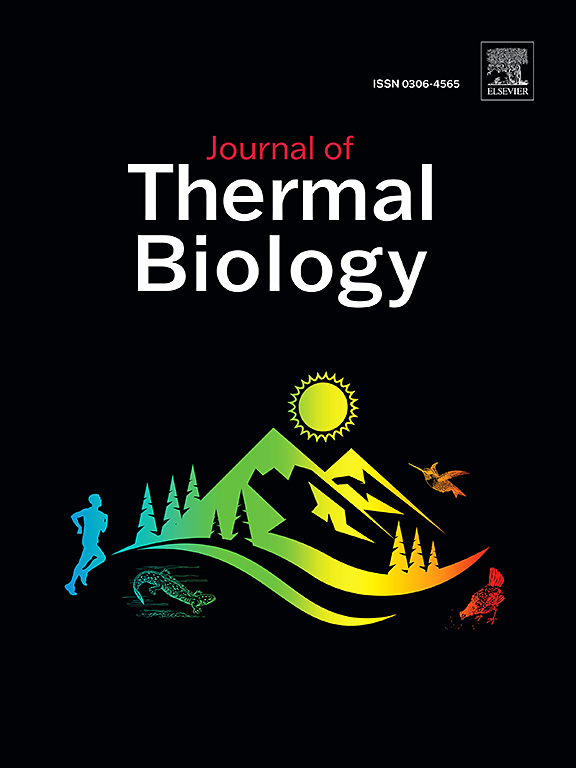热空气通过ERK1/2信号介导的铁凋亡损伤人肺泡上皮细胞。
IF 2.9
2区 生物学
Q2 BIOLOGY
引用次数: 0
摘要
吸入性肺损伤是由于吸入热空气和/或有毒气体而引起的急性肺损伤。然而,热空气诱导的肺泡上皮细胞热应激反应的分子机制尚不完全清楚。在本研究中,我们利用细胞热负荷装置,发现HS在50°C下导致人类肺泡上皮细胞(BEAS-2B细胞)明显的铁凋亡和损伤,其支持机制是脂质过氧化、活性氧(ROS)增加,铁蛋白重链1 (FTH1)、谷胱甘肽过氧化物酶4 (GPX4)、溶质载体家族7成员11 (SLC7A11)减少。铁抑素-1 (Ferrostatin-1, fe -1)是一种铁下垂的靶向抑制剂,可以抑制hs诱导的BEAS-2B细胞的铁下垂和损伤。此外,HS激活了BEAS-2B细胞的细胞外信号调节激酶1/2 (ERK1/2)。然而,ERK1/2磷酸化抑制剂U0126阻断ERK1/2激活,抑制hs诱导的BEAS-2B细胞铁凋亡和损伤。综上所述,本研究表明HS通过ERK1/2信号介导的铁上沉损伤肺泡上皮细胞,这为HS诱导的吸入性肺损伤的治疗提供了一种新的潜在策略。本文章由计算机程序翻译,如有差异,请以英文原文为准。

Hot air injures human alveolar epithelial cells through ERK1/2 signaling-mediated ferroptosis
Inhalation lung injury is an acute pulmonary impairment resulting from inhalation of hot air and/or toxic gases. However, the molecular mechanisms involved in hot air-induced heat stress (HS) response of alveolar epithelial cells are not fully understood. In this study, employing a cell heat loading device, we found that HS at 50 °C resulted in significant ferroptosis and injury of human alveolar epithelial cells (BEAS-2B cells), supported by increased lipid peroxidation, reactive oxygen species (ROS), and decreased ferritin heavy chain 1 (FTH1), glutathione peroxidase 4 (GPX4), solute carrier family 7 member 11 (SLC7A11). Ferrostatin-1 (Fer-1), a targeted inhibitor of ferroptosis, could suppress HS-induced ferroptosis and injury of BEAS-2B cells. Moreover, HS activated extracellular signal-regulated kinase 1/2 (ERK1/2) in BEAS-2B cells. Nevertheless, blockage of ERK1/2 activation by U0126, an inhibitor of ERK1/2 phosphorylation, repressed HS-induced ferroptosis and injury of BEAS-2B cells. Taken together, this study demonstrates that HS injures alveolar epithelial cells through ERK1/2 signaling-mediated ferroptosis, which provides a novel potential strategy for the treatment of HS-induced inhalation lung injury.
求助全文
通过发布文献求助,成功后即可免费获取论文全文。
去求助
来源期刊

Journal of thermal biology
生物-动物学
CiteScore
5.30
自引率
7.40%
发文量
196
审稿时长
14.5 weeks
期刊介绍:
The Journal of Thermal Biology publishes articles that advance our knowledge on the ways and mechanisms through which temperature affects man and animals. This includes studies of their responses to these effects and on the ecological consequences. Directly relevant to this theme are:
• The mechanisms of thermal limitation, heat and cold injury, and the resistance of organisms to extremes of temperature
• The mechanisms involved in acclimation, acclimatization and evolutionary adaptation to temperature
• Mechanisms underlying the patterns of hibernation, torpor, dormancy, aestivation and diapause
• Effects of temperature on reproduction and development, growth, ageing and life-span
• Studies on modelling heat transfer between organisms and their environment
• The contributions of temperature to effects of climate change on animal species and man
• Studies of conservation biology and physiology related to temperature
• Behavioural and physiological regulation of body temperature including its pathophysiology and fever
• Medical applications of hypo- and hyperthermia
Article types:
• Original articles
• Review articles
 求助内容:
求助内容: 应助结果提醒方式:
应助结果提醒方式:


